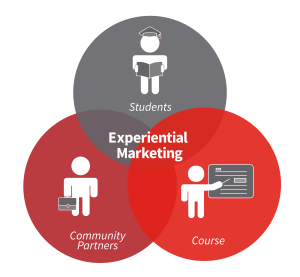3.3 Course Structure

The structure of Community Consultancy/Employer Rounds revolves around three main components: the students, the community partners, and the course instructor.
- Students are divided into collaborative teams where they work with real-world clients, gaining hands-on experience and valuable insights into marketing strategies and market research.
- Community Partners contact the course lead/faculty member and share their marketing goals or needs. Most small businesses or entrepreneurs are busy running their companies and often put marketing efforts last because they either don’t have the marketing knowledge or the capacity to focus on this. Businesses provide students with marketing projects based on their specific business goals, fostering a mutually beneficial relationship where the students’ creativity and fresh perspectives bring innovative solutions to the organizations.
- The course instructor acts as the facilitator or mentor, guiding students through the process, ensuring proper project management, and fostering an environment for growth and development.
The experiential learning structure of this consultancy course provides students with the opportunity to bridge the gap between their academic journey and future careers in marketing. Through collaborations with actual clients and by tackling tangible marketing obstacles, they cultivate the confidence and expertise necessary to succeed in the Marketing Industry. This immersive approach goes beyond theoretical concepts, harnessing the potency of putting knowledge into action. Ultimately, it propels our students seamlessly from their academic journey into the fast-paced world of professional marketing, armed with the strength of real-world experience.

